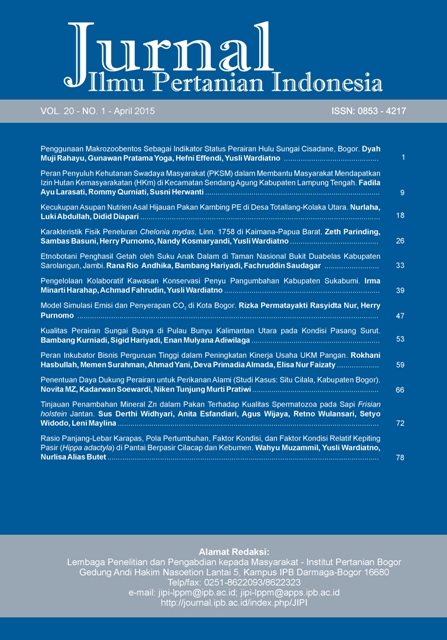Model Simulasi Emisi dan Penyerapan CO2 di Kota Bogor
Abstract
Most of the urban pollution is the result of carbon dioxide (CO2) emission from human activities. This research identified CO2 emission and absorption in Bogor, and also the alternatives to solve the emission problem by system model and simulation. CO2 emission and absorption system model was created using software Stella 9.0.2 based on loss-gain emission concept for 30 years prediction. Human activities that contribute to CO2 emission are transportation, industries, energy consumption such as fuel or electricity, house hold waste, and farms, while the decrease factor is green open spaces as CO2 sequester. The alternatives to solve emission problem in Bogor is created based on green city concept by including the environmental aspects in every urban activity. The result of this research, the CO2 emission of Bogor reached 20.027.878 tons and the absorption reached 93.843 tons in 2042. Combined mitigation alternatives in several sectors could reduce CO2 emission by 2.797.667 tons in 2042 and CO2 emission could be neutralized by reforestation in 2036.
Downloads
References
Ananthakrishnan R, Sudhakar K, Goyal A, Sravan SS. 2013. Economic Feasibility of Substituting LPG with Biogas for MANIT Hostels. Internatio-nal Journal of Chemtech Research. 5(2): 891-893.
[BPS] Badan Pusat Statistik. 2008. Kota Bogor Dalam Angka 2008.
[BPS] Badan Pusat Statistik. 2009. Kota Bogor Dalam Angka 2009.
[BPS] Badan Pusat Statistik. 2010. Kota Bogor Dalam Angka 2010.
[BPS] Badan Pusat Statistik. 2011. Kota Bogor Dalam Angka 2011.
[BPS] Badan Pusat Statistik. 2012. Kota Bogor Dalam Angka 2012.
Boer R, Dewi RG, Siagian UWR, Ardiansyah M, Surmaini E, Ridha DM, Gani M, Rukmi WA, Gunawan A, Utomo P, Setiawan G, Irwani S, Parinderati R. 2012. Pedoman Penyelenggaraan Inventarisasi Gas Rumah Kaca Nasional. Jakarta (ID): Kementrian Lingkungan Hidup.
Dahlan EN. 2011. Kebutuhan luasan areal hutan kota sebagai rosot (sink) gas CO2 untuk mengantisipasi penurunan luasan ruang terbuka hijau di Kota Bogor. Forum Geografi. 25(2): 164-177.
Friedlingstein P, Houghton RA, Marland G. 2010. Update on CO2 emissions. Nature Geoscience. 3(12): 811- 812. doi: 10.1038/ngeo1022.
Guy ED, Levine NS. 2001. GIS modeling and analysis of Ohio’s CO2 budget: mitigation CO2 emissions through reforestation. Ohio Journal of Science (Ohio Academy of Science). 101(3): 34-41.
Houghton RA, House JI, Pongratz J, Van der Werf GR, DeFries RS, Hansen MC, Le Qu´er´e C, Ramankutty N. 2012. Carbon emissions from land use and land-cover change. Biogeoscience. 9(12): 5125-5142.
Pratiwi WAK, Hermana J. 2013. Analisis pengurangan emisi CO2 melalui manajemen penggunaan listrik dan ketersediaan ruang terbuka hijau di Gedung Perkantoran Pemerintah Kota Surabaya. Jurnal Teknik Pomits. 2(3): 214-217.
Purnomo H. 2012. Pemodelan dan Simulasi untuk Pengelolaan Adaptif Sumber Daya Alam dan Lingkungan. IPB Press, Bogor (ID).
Rushayati SB. 2012. Model kota hijau di Kabupaten Bandung Jawa Barat. [Disertasi]. Bogor (ID): Institut Pertanian Bogor.
Saraswati AA. 2008. Keberadaan ruang terbuka hijau dalam kawasan industri. Jurnal Teknik Lingkungan. Edisi Khusus: 01-08.
Soccol CR, Vandenberghe LPS, Costa B, Woiciechowski AL, Carvalho JC, Medeiros ABP, Francisco AM, Bonomi LJ. 2005. Brazilian biofuel program: An overview. Journal of Scientific & Industrial Research. 64(11): 897-904.
Sugiyono A. 2000. Studi pendahuluan untuk analisis energi – exergi Kota Jakarta. [Laporan teknis]. Jakarta (ID): Badan Pengkajian dan Penerapan Teknologi.
Wasis B, Saharjo BH, Arifin HS, Prasetyo ANN. 2012. Perubahan penutupan lahan dan dampaknya terhadap stok karbon permukaan pada Daerah Aliran Sungai Ciliwung [Land covers change and its impact to carbon stocks in Watershed Ciliwung]. Jurnal Silvikultur Tropika. 03(02): 108-113.
Wulandari MT, Hermawan, Purwanto. 2013. Kajian Emisi CO2 berdasarkan Penggunaan Energi Rumah Tangga sebagai Penyebab Pemanasan Global (Studi Kasus perumahan Sebantengan, Gedang Asri, Susukan RW 07 Kab. Semarang). Seminar Nasional Pengelolaan Sumber daya Alam dan Lingkungan; 2013 Agust 27; Semarang, Indonesia. Semarang (ID): Universitas Diponegoro. hlm 434-440.
This journal is published under the terms of the Creative Commons Attribution-NonCommercial 4.0 International License. Authors who publish with this journal agree to the following terms: Authors retain copyright and grant the journal right of first publication with the work simultaneously licensed under a Creative Commons Attribution-NonCommercial 4.0 International License. Attribution — You must give appropriate credit, provide a link to the license, and indicate if changes were made. You may do so in any reasonable manner, but not in any way that suggests the licensor endorses you or your use. NonCommercial — You may not use the material for commercial purposes.


















